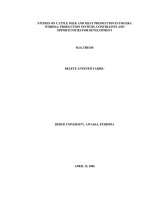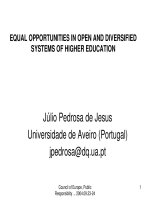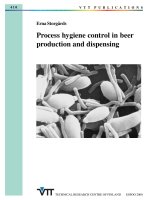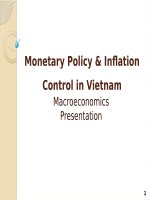Chemical weed control in chilli + onion intercropping system
Bạn đang xem bản rút gọn của tài liệu. Xem và tải ngay bản đầy đủ của tài liệu tại đây (246.42 KB, 11 trang )
Int.J.Curr.Microbiol.App.Sci (2019) 8(1): 3111-3121
International Journal of Current Microbiology and Applied Sciences
ISSN: 2319-7706 Volume 8 Number 01 (2019)
Journal homepage:
Original Research Article
/>
Chemical Weed Control in Chilli + Onion Intercropping System
Vilas D. Gasti* and Snehasish Chakravorty
Department of Horticulture and Post-harvest Technology Palli Siksha Bhavana (Institute of
Agriculture) Sriniketan, Visva-Bharati (West Bengal) – 731236, India
*Corresponding author
ABSTRACT
Keywords
Chilli + onion
intercropping,
Weed control
treatments and B :
C Ratio
Article Info
Accepted:
26 December 2018
Available Online:
10 January 2019
An investigation entitled “Chemical weed control in chilli + onion intercropping system”
was carried out at the Vegetable Division in Kittur Rani Channamma College of
Horticulture, Arabhavi, University of Horticultural Sciences, Bagalkot (Karnataka) during
Kharif season of 2014 and 2015 on well drained red loamy soil to find out the suitable
approach (herbicides+cultural practices) for weed management and for improving the
productivity of chilli+onion intercropping system. Observations on weed control
treatments showed marked difference among weed, growth and yield parameters in chilli
and onion. Among the different chemical treatments, pre-emergent application of alachlor
@ 1.5 kg ai/ha + 2 HW at 45 and 60 DAT (T 4) recorded the lowest pooled dry matter of
weeds (1.97 g), lowest population of monocot (3.68) and dicot weeds (3.11) and thus
exhibited the highest weed control efficiency (93.04%). Unweeded check recorded highest
weed population (13.16) and weed dry weight (7.47 g). Significantly higher yield per ha of
green chilli(253.41 q) and onion (221.26 q), net returns (Rs.2,14,413) and B:C ratio (3.4)
was recorded in T4 followed by pendimethalin @ 1.5 kg ai/ha + 2 HW at 45 and 60 DAT.
Introduction
Weeds are unwanted and undesirable plants
that interfere with utilization of land and
water resources and thus adversely affect crop
production and human welfare. They are often
prolific and persistent, interfere with
agricultural operations, increase labour cost
and reduce the yield (up to 45 %) and quality.
The weed flora noticed in the experimental
site consisted of grasses, sedges and broad
leaved weed category. The important grassy
weeds observed are Cynodon dactylon,
Dinebra retroflexa, Eleusine indica, Cyperus
rotundus and Setaria italica. C. rotundus was
more dominated than other weeds in entire
experimental area. In Karnataka, chilli and
onion are the most extensively grown
commercial
vegetable
crops
under
intercropping
systems.
Chilli+onion
intercropping is of the most assured
intercropping system and mitigate the weeds
to some extent and increases the yield and is
found suitable to northern dry zones of
Karnataka. This system is widely adopted in
Northern Karnataka (Anonymous, 2017).
3111
Int.J.Curr.Microbiol.App.Sci (2019) 8(1): 3111-3121
In general, weeds are considered to be one of
the major production constraints in chilli and
onion. Timely weeding reduces the crop weed
competition and leads to higher crop yields.
Hand weeding, though an efficient method it
is laborious, costly, time consuming and
unsuitable for large farms. The cost involved
in hand weeding and unavailability of labours
for manual weeding has necessitated the use
of chemicals for weed control in developing
countries like India. Information regarding
weed management through herbicides in
intercropping is limited and very little work
has been done on weed management in chilli+
onion intercropping system in particular. In
view of acute early results to mitigate weeds
through chemical weed management strategy
for chilli + onion intercropping system, the
present investigation was carried out.
Chilli and onion is the most important cash
crops of India, playing a key role in economic
and social affairs. In intercropping system,
fewer weeds are expected than in sole crop
because of their better suppression. Some
research findings related to weed management
reported that weed suppression as a result of
intercropping is to the extent of 50 to 75 per
cent (Biradar, 1999). However management
of weeds in intercropping or mixed cropping
system is complicated due to spatial and
temporal differences in the arrangement of
crops. Shallow root system of onion prevents
mechanical weeding.
Smothering effect of intercrop in onion is
absent due to slow initial growth. Hence,
chemical weed control is also difficult due to
simultaneous sowing of two or more crops but
selective herbicides play a key role in
suppression of weeds in intercropping due to
simultaneous suppression of weeds by
smothering effect (Muthusankaranarayanan et
al., 1997). Large stretches of chilli + onion
intercropping system in northern dry zone of
Karnataka is indicative of its high
productiveness and certainly in obtaining the
yields. Mechanical weeding is difficult as the
onion rows are closely spaced are often
planted in both the directions as practiced by
farmers of this region.
Materials and Methods
The study was carried out at the Vegetable
Division in Kittur Rani Channamma College
of Horticulture, Arabhavi, University of
Horticultural Sciences, Bagalkot (Karnataka)
during Kharif season of 2014 and 2015 on a
well-drained red loamy soil to find out the
effectiveness of chemicals in weed
management in intercropping of chilli (Var
„Byadagi‟)+ onion (Var „N-53‟).
The field experiment was laid out in a
Randomized Complete Block Design with
two replications consisting of fourteen
treatments including unweeded check (T1 Alachlor (PE)-1.5 kg ai/ha T2 - Alachlor (PE)1.0 kg ai/ha T3 - Alachlor (PE)-1.5 kg ai/ha +
1 HW at 45 DAT T4 - Alachlor (PE)-1.5 kg
ai/ha + 2 HW at 45 and 60 DAT T5 - Alachlor
(PE)-1.0 kg ai/ha + 1 HW at 45 DAT T6 Alachlor (PE)-1.0 kg ai/ha + 2 HW at 45 and
60 DAT T7 - Pendimethalin (PE)-1.5 kg ai/ha
T8 - Pendimethalin (PE)-1.0 kg ai/ha T9 Pendimethalin (PE)-1.5 kg ai/ha+ 1 HW at 45
DAT T10 - Pendimethalin (PE)-1.5 kg ai/ha +
2 HW at 45 and 60 DAT T11 - Pendimethalin
(PE)-1.0 kg ai/ha + 1 HW at 45 DAT T12 Pendimethalin (PE)-1.0 kg ai/ha + 2 HW at
45 and 60 DAT T13 - Weed free check T14 Unweeded check). RDF for chilli is
150:100:125 kg of N: P2O5: K2O with 25
tonnes of FYM (As per package of practices –
UHS, Bagalkot Karnataka).
The gross size and net size of the plots were
16.20 m2 and 11.80 m2 respectively. Four to
five weeks old chilli seedlings are
transplanted into main field with a spacing of
75cm × 45 cm (As per package of practices -
3112
Int.J.Curr.Microbiol.App.Sci (2019) 8(1): 3111-3121
UHS, Bagalkot) and in between the chilli
plants, 2 rows of onion was planted. Basal
dose of fertilizer (50 % N and full dose of P
and K) was applied to each treatment at the
time of field preparation. Remaining dose of
N (50 %) was applied at 3 split doses viz.,
after 30, 60 and 90 days of transplanting.
During the course of investigation,
observations regarding weed population,
growth and yield parameters at 30, 60 and 90
DAT and at the time of harvest were recorded
from the randomly selected and tagged plants.
The weed index was calculated by the
formula given by Gill and Vijayakumar
(1969). Besides fixed cost of cultivation,
variable costs on spray, manual weeding and
cost of herbicide in each treatment was
worked out to obtain total cost of production.
The net income was obtained after deducting
cost of production from value of produces.
The mean data was subjected to the statistical
analysis using ANOVA and mean separation
(LSD) procedures (Gomez and Gomez, 1984).
Results and Discussion
The results of the study showed that among
different chemical treatments, the effect of
weed control on monocot weeds (3.68), dicot
weeds (3.11) and weed population at harvest
(4.82) was found to be significantly less in
treatment with pre-emergent application of
alachlor-1.5 kg ai/ha + 2HW at 45 and 60
DAT(T4) over unweeded check ie, T14. This
was found to be on par with T10
(Pendimethalin (PE)-1.5 kg ai/ha + 2 HW at
45 and 60 DAT) (3.95, 3.26 and 5.12,
respectively) (Table 1).
The treatment T4 recorded lowest dry weight
of weeds at harvest (1.97 g), lowest weed
index in chilli and onion (11.80 and 6.05,
respectively) and thus highest weed control
efficiency (93.04 %) (Table 2).The lower dry
weight of weeds in these treatments might be
attributed to the less number of weeds. Thus
the higher weed control efficiency could be
accounted to the lower weed dry weight.
These results are of agreement with Ningappa
(2013), Shil and Adhikary (2014) and
Chaudhari et al., (2017).
Treatment T4 was found significant for
highest plant height (104.88 cm), number of
branches/ plant (24.47), dry weight of plant
(106.39 g) and number of fruits/plant at
harvest (119.34) in chilli (Table 3). The mean
analyses showed that highest fruit wt. /plant
(1.08 kg) was recorded in T4 followed by T10
(1.04 kg) and minimum was recorded from
the unweeded check, T14 (0.41 kg). Reduced
yield from the unweeded plot may be
attributed to increased competition for light,
soil moisture and nutrients. Fruit yield per ha
(253.41 q) of chilli was found highest in T4
while lowest was found in T14 (101.45 q)
(Table 4). Similar findings are reported by
Rajakumara (2009), Kalasare et al., (2016)
and Ningappa (2013).
Yield and yield components of onion varied
significantly among various weed control
treatments. Treatment T4 was found
significant for highest plant height (59.60 cm)
and number of leaves/plant at harvest (15.29)
in onion (Table 5). Weed free check recorded
significantly highest dry weight of plant (8.00
g), yield per plant (84.80 g) and yield per ha
(235.54 q). Among the chemical treatments,
T4 recorded highest dry weight of plant (7.57
g), yield per plant (79.66 g) and yield per ha
(221.26 q) (Table 6).
The increase in plant dry matter and yield per
plant in these treatments could be attributed to
lower weed count and higher weed control
efficiency which ultimately resulted in better
crop growth leading to higher productivity.
The results are in agreement with Dharmatti
et al., (2008), Kalasare (2016) and Urraiya
and Jha (2018).
3113
Int.J.Curr.Microbiol.App.Sci (2019) 8(1): 3111-3121
Table.1 Effect of weed control treatments on weed parameters in chilli + onion intercropping
Treaments
Treatment details
Monocot weeds at harvest
I
II
pooled
year
year
Dicot weeds at harvest
I
II
Pooled
year
year
T1
Alachlor (PE)-1.5 kg ai/ha
T2
Alachlor (PE)-1.0 kg ai/ha
T3
Alachlor (PE)-1.5 kg ai/ha + 1 HW at 45 DAT
T4
Alachlor (PE)-1.5 kg ai/ha + 2 HW at 45 and 60 DAT
T5
Alachlor (PE)-1.0 kg ai/ha + 1 HW at 45 DAT
T6
Alachlor (PE)-1.0 kg ai/ha + 2 HW at 45 and 60 DAT
T7
Pendimethalin (PE)-1.5 kg ai/ha
T8
Pendimethalin (PE)-1.0 kg ai/ha
T9
Pendimethalin (PE)-1.5 kg ai/ha+ 1 HW at 45 DAT
T10
Pendimethalin (PE)-1.5 kg ai/ha + 2 HW at 45 and 60
DAT
Pendimethalin (PE)-1.0 kg ai/ha + 1 HW at 45 DAT
54.15
(7.36)
63.25
(7.95)
37.45
(6.12)
12.68
(3.56)
42.15
(6.49)
28.88
(5.37)
60.95
(7.81)
67.15
(8.19)
45.38
(6.74)
14.70
(3.83)
53.58
(7.32)
31.45
(5.61)
0.00
(0.71)
106.18
(10.30)
44.14
(6.24)
0.08
0.24
28.35
(5.32)
37.15
(6.09)
17.41
(4.17)
8.89
(2.98)
19.38
(4.40)
10.80
(3.28)
33.15
(5.76)
40.18
(6.34)
20.90
(4.57)
9.85
(3.14)
23.98
(4.90)
12.46
(3.53)
0.00
(0.71)
65.41
(8.09)
23.42
(4.52)
0.04
0.16
29.93
(5.47)
38.72
(6.22)
18.99
(4.36)
10.51
(3.24)
21.00
(4.58)
12.37
(3.52)
34.73
(5.89)
41.81
(6.47)
22.51
(4.74)
11.45
(3.38)
25.59
(5.06)
14.04
(3.74)
0.00
(0.71)
67.01
(8.19)
23.42
(4.52)
0.04
0.16
T11
T13
Pendimethalin (PE)-1.0 kg ai/ha + 2 HW at 45 and 60
DAT
Weed free check
T14
Unweeded check
T12
Mean
S. Em
C. D. @ 5%
3114
55.87
(7.47)
64.95
(8.06)
39.16
(6.26)
14.35
(3.79)
43.86
(6.62)
30.56
(5.53)
62.68
(7.92)
68.88
(8.30)
47.10
(6.86)
16.44
(4.05)
55.28
(7.44)
33.40
(5.78)
0.00
(0.71)
107.89
(10.38)
45.74
(6.37)
0.08
0.25
55.01
(7.42)
64.10
(8.00)
38.30
(6.19)
13.52
(3.68)
43.00
(6.56)
29.72
(5.45)
61.82
(7.86)
68.01
(8.25)
46.24
(6.80)
15.57
(3.95)
54.43
(7.38)
32.43
(5.69)
0.00
(0.71)
107.03
(10.34)
44.94
(6.30)
0.08
0.24
29.14
(5.40)
37.93
(6.16)
18.20
(4.26)
9.70
(3.11)
20.19
(4.49)
11.59
(3.40)
33.94
(5.83)
40.99
(6.40)
21.70
(4.66)
10.65
(3.26)
24.79
(4.98)
13.25
(3.64)
0.00
(0.71)
66.21
(8.14)
24.16
(4.60)
0.04
0.16
Weed population at harvest
I
II
Pooled
year
year
82.50
(9.08)
100.40
(10.02)
54.86
(7.41)
21.57
(4.64)
61.53
(7.84)
39.68
(6.30)
94.10
(9.70)
107.33
(10.36)
66.28
(8.14)
24.55
(4.95)
77.56
(8.81)
43.91
(6.62)
0.00
(0.71)
171.59
(13.10)
67.56
(7.64)
0.07
0.28
85.80
(9.26)
103.67
(10.18)
58.15
(7.62)
24.86
(4.99)
64.86
(8.05)
42.93
(6.55)
97.41
(9.87)
110.68
(10.52)
69.61
(8.34)
27.89
(5.28)
80.87
(8.99)
47.44
(6.89)
0.00
(0.71)
174.89
(13.22)
70.68
(7.88)
0.12
0.32
84.15
(9.17)
102.03
(10.10)
56.50
(7.52)
23.21
(4.82)
63.19
(7.95)
41.31
(6.43)
95.75
(9.78)
109.01
(10.44)
67.94
(8.24)
26.22
(5.12)
79.22
(8.90)
45.67
(6.76)
0.00
(0.71)
173.24
(13.16)
69.12
(7.77)
0.09
0.28
Int.J.Curr.Microbiol.App.Sci (2019) 8(1): 3111-3121
Table.2 Effect of weed control treatments on weed parameters in chilli + onion intercropping
Treatments
Treatment details
T1
Alachlor (PE)-1.5 kg ai/ha
T2
Alachlor (PE)-1.0 kg ai/ha
T3
Alachlor (PE)-1.5 kg ai/ha + 1 HW at 45 DAT
T4
Alachlor (PE)-1.5 kg ai/ha + 2 HW at 45 and 60 DAT
T5
Alachlor (PE)-1.0 kg ai/ha + 1 HW at 45 DAT
T6
Alachlor (PE)-1.0 kg ai/ha + 2 HW at 45 and 60 DAT
T7
Pendimethalin (PE)-1.5 kg ai/ha
T8
Pendimethalin (PE)-1.0 kg ai/ha
T9
Pendimethalin (PE)-1.5 kg ai/ha+ 1 HW at 45 DAT
T10
Pendimethalin (PE)-1.5 kg ai/ha + 2 HW at 45 and 60
DAT
Pendimethalin (PE)-1.0 kg ai/ha + 1 HW at 45 DAT
T11
T13
Pendimethalin (PE)-1.0 kg ai/ha + 2 HW at 45 and 60
DAT
Weed free check
T14
Unweeded check
T12
Mean
S. Em
C. D. @ 5%
Dry weight of weeds
at harvest (g)
I
II
Pooled
year
year
31.60 32.58 32.09
(5.62) (5.71) (5.66)
34.19 35.19 34.69
(5.85) (5.93) (5.89)
22.67 23.67 23.17
(4.76) (4.86) (4.81)
3.39
4.39
3.89
(1.84) (2.09) (1.97)
24.34 25.35 24.84
(4.93) (5.03) (4.98)
10.71 11.70 11.20
(3.27) (3.42) (3.34)
33.43 34.45 33.94
(5.78) (5.87) (5.82)
36.54 37.53 37.04
(6.04) (6.13) (6.09)
28.43 29.44 28.93
(5.33) (5.43) (5.38)
4.25
5.25
4.75
(2.06) (2.29) (2.18)
28.66 29.65 29.16
(5.35) (5.44) (5.40)
14.08 15.07 14.57
(3.75) (3.88) (3.82)
0.00
0.00
0.00
(0.71) (0.71) (0.71)
55.27 56.24 55.76
(7.43) (7.50) (7.47)
44.14 23.40 24.32
(6.24) (4.48) (4.59)
0.08
0.10
0.10
0.24
0.33
0.32
3115
Weed control
efficiency at harvest
I
II
Pooled
year
year
42.75 42.00 42.37
Weed index in chilli
I
year
19.15
II
year
19.59
Pooled
38.15
37.43
37.79
21.30
58.92
57.86
58.39
93.88
92.22
55.88
Weed index in onion
II
year
17.55
Pooled
19.38
I
year
16.25
21.73
21.52
16.82
18.34
17.60
15.31
15.78
15.55
13.09
14.48
13.81
93.04
11.53
12.07
11.80
4.97
7.07
6.05
54.86
55.36
15.75
16.25
16.01
15.17
16.35
15.78
80.67
79.23
79.94
13.28
13.82
13.56
7.79
9.40
8.62
39.43
38.67
39.05
20.22
20.67
20.45
16.59
18.01
17.33
33.88
33.26
33.57
22.79
23.19
22.99
17.27
18.46
17.88
48.50
47.59
48.04
16.85
17.29
17.08
15.73
17.00
16.38
92.33
90.68
91.50
12.61
13.17
12.89
5.52
7.47
6.53
48.16
47.29
47.72
18.26
18.74
18.50
15.96
17.43
16.72
74.49
73.17
73.82
14.59
15.14
14.87
9.85
11.53
10.72
100.0
0
0.00
100.0
0
0.00
100.0
0
0.00
0.00
0.00
0.00
0.00
0.00
0.00
62.64
63.59
63.12
56.63
56.31
58.66
23.86
(4.54)
0.10
0.32
57.65
56.73
57.19
18.88
19.36
15.12
16.39
16.39
1.79
5.62
1.75
5.44
1.77
5.53
1.67
5.10
1.73
5.37
3.15
9.42
3.04
9.05
3.04
9.05
16.92
Int.J.Curr.Microbiol.App.Sci (2019) 8(1): 3111-3121
Table.3 Effect of weed control treatments on growth and yield parameters in chilli
Treatments
Treatment details
Fruit weight per plant
Yield per plot (kg)
(kg)
I
II
Pooled I
II
Pooled
year
year
year
year
35.80
36.18
35.99
0.94 0.95 0.95
T1
Alachlor (PE)-1.5 kg ai/ha
T2
Alachlor (PE)-1.0 kg ai/ha
0.92
0.93
0.92
34.88
35.26
T3
Alachlor (PE)-1.5 kg ai/ha + 1 HW at 45 DAT
0.99
1.00
0.99
37.48
T4
Alachlor (PE)-1.5 kg ai/ha + 2 HW at 45 and 60 DAT
1.08
1.09
1.08
T5
Alachlor (PE)-1.0 kg ai/ha + 1 HW at 45 DAT
0.98
0.99
T6
Alachlor (PE)-1.0 kg ai/ha + 2 HW at 45 and 60 DAT
1.01
T7
Pendimethalin (PE)-1.5 kg ai/ha
T8
Yield per ha(q)
I
year
II
year
Pooled
221.00
223.35
222.18
35.07
215.30
217.65
216.47
37.86
37.67
231.36
233.71
232.53
40.86
41.24
41.05
252.24
254.59
253.41
0.98
37.32
37.70
37.51
230.38
232.73
231.55
1.02
1.02
38.41
38.79
38.60
237.10
239.45
238.27
0.93
0.94
0.94
35.35
35.73
35.54
218.23
220.58
219.40
Pendimethalin (PE)-1.0 kg ai/ha
0.90
0.91
0.91
34.20
34.58
34.39
211.11
213.46
212.28
T9
Pendimethalin (PE)-1.5 kg ai/ha+ 1 HW at 45 DAT
0.97
0.98
0.97
36.79
37.17
36.98
227.09
229.43
228.26
T10
Pendimethalin (PE)-1.5 kg ai/ha + 2 HW at 45 and 60
DAT
Pendimethalin (PE)-1.0 kg ai/ha + 1 HW at 45 DAT
1.03
1.04
1.04
39.16
39.54
39.35
241.70
244.05
242.87
0.95
0.96
0.96
36.23
36.61
36.42
223.63
225.97
224.80
1.00
1.01
1.00
37.87
38.25
38.06
233.76
236.11
234.93
T13
Pendimethalin (PE)-1.0 kg ai/ha + 2 HW at 45 and 60
DAT
Weed free check
1.11
1.13
1.12
42.21
42.97
42.59
260.56
265.25
262.90
T14
Unweeded check
0.44
0.43
0.41
16.53
16.34
16.44
102.04
100.86
101.45
0.95
0.96
0.95
35.94
36.30
36.12
221.82
224.08
222.95
0.03
0.04
0.04
1.33
1.44
1.38
8.19
8.87
8.52
0.09
0.12
0.15
3.65
4.32
4.18
24.90
27.10
26.29
T11
T12
Mean
S. Em
C. D. @ 5%
3116
Int.J.Curr.Microbiol.App.Sci (2019) 8(1): 3111-3121
Table.4 Effect of weed control treatments on yield and yield attributes in chilli
Treatments
Treatment details
Fruit weight per plant
(kg)
Yield per plot (kg)
Yield per ha(q)
I
year
II Pooled
year
I
year
II
year
Pooled
I
year
II
year
Pooled
T1
Alachlor (PE)-1.5 kg ai/ha
0.94
0.95
0.95
35.80
36.18
35.99
221.00
223.35
222.18
T2
Alachlor (PE)-1.0 kg ai/ha
0.92
0.93
0.92
34.88
35.26
35.07
215.30
217.65
216.47
T3
Alachlor (PE)-1.5 kg ai/ha + 1 HW at 45 DAT
0.99
1.00
0.99
37.48
37.86
37.67
231.36
233.71
232.53
T4
Alachlor (PE)-1.5 kg ai/ha + 2 HW at 45 and 60 DAT
1.08
1.09
1.08
40.86
41.24
41.05
252.24
254.59
253.41
T5
Alachlor (PE)-1.0 kg ai/ha + 1 HW at 45 DAT
0.98
0.99
0.98
37.32
37.70
37.51
230.38
232.73
231.55
T6
Alachlor (PE)-1.0 kg ai/ha + 2 HW at 45 and 60 DAT
1.01
1.02
1.02
38.41
38.79
38.60
237.10
239.45
238.27
T7
Pendimethalin (PE)-1.5 kg ai/ha
0.93
0.94
0.94
35.35
35.73
35.54
218.23
220.58
219.40
T8
Pendimethalin (PE)-1.0 kg ai/ha
0.90
0.91
0.91
34.20
34.58
34.39
211.11
213.46
212.28
T9
Pendimethalin (PE)-1.5 kg ai/ha+ 1 HW at 45 DAT
0.97
0.98
0.97
36.79
37.17
36.98
227.09
229.43
228.26
T10
Pendimethalin (PE)-1.5 kg ai/ha + 2 HW at 45 and 60
DAT
1.03
1.04
1.04
39.16
39.54
39.35
241.70
244.05
242.87
T11
Pendimethalin (PE)-1.0 kg ai/ha + 1 HW at 45 DAT
0.95
0.96
0.96
36.23
36.61
36.42
223.63
225.97
224.80
T12
Pendimethalin (PE)-1.0 kg ai/ha + 2 HW at 45 and 60
DAT
1.00
1.01
1.00
37.87
38.25
38.06
233.76
236.11
234.93
T13
Weed free check
1.11
1.13
1.12
42.21
42.97
42.59
260.56
265.25
262.90
T14
Unweeded check
0.44
0.43
0.41
16.53
16.34
16.44
102.04
100.86
101.45
0.95
0.96
0.95
35.94
36.30
36.12
221.82
224.08
222.95
0.03
0.04
0.04
1.33
1.44
1.38
8.19
8.87
8.52
0.09
0.12
0.15
3.65
4.32
4.18
24.90
27.10
26.29
Mean
S. Em
C. D. @ 5%
3117
Int.J.Curr.Microbiol.App.Sci (2019) 8(1): 3111-3121
Table.5 Effect of weed control treatments on growth parameters in onion
Treatments
Treatment details
Plant height at 90 DAT
(cm)
No. of leaves per plant
at 90 DAT
I
year
II
year
Pooled
I
year
II
year
Pooled
T1
Alachlor (PE)-1.5 kg ai/ha
52.20
53.10
52.65
12.88
13.53
13.20
T2
Alachlor (PE)-1.0 kg ai/ha
50.70
51.60
51.15
12.43
13.18
12.80
T3
Alachlor (PE)-1.5 kg ai/ha + 1 HW at 45 DAT
56.00
56.80
56.40
13.78
14.33
14.05
T4
Alachlor (PE)-1.5 kg ai/ha + 2 HW at 45 and 60 DAT
59.20
60.00
59.60
14.98
15.60
15.29
T5
Alachlor (PE)-1.0 kg ai/ha + 1 HW at 45 DAT
55.40
56.30
55.85
13.53
14.28
13.90
T6
Alachlor (PE)-1.0 kg ai/ha + 2 HW at 45 and 60 DAT
57.00
57.95
57.47
14.48
15.08
14.78
T7
Pendimethalin (PE)-1.5 kg ai/ha
51.20
52.00
51.60
12.58
13.33
12.95
T8
Pendimethalin (PE)-1.0 kg ai/ha
50.50
51.40
50.95
12.08
12.83
12.45
T9
Pendimethalin (PE)-1.5 kg ai/ha+ 1 HW at 45 DAT
53.90
54.80
54.35
13.28
13.78
13.53
T10
Pendimethalin (PE)-1.5 kg ai/ha + 2 HW at 45 and 60 DAT
57.90
58.70
58.30
14.58
15.33
14.95
T11
Pendimethalin (PE)-1.0 kg ai/ha + 1 HW at 45 DAT
52.70
53.75
53.22
13.11
13.56
13.34
T12
Pendimethalin (PE)-1.0 kg ai/ha + 2 HW at 45 and 60 DAT
56.60
57.50
57.05
14.18
14.93
14.55
T13
Weed free check
59.80
60.90
60.35
15.43
16.33
15.88
T14
Unweeded check
48.80
49.55
49.17
11.88
12.33
12.10
54.42
55.31
54.86
13.51
14.17
13.84
2.12
2.13
2.12
0.55
0.52
0.53
6.01
6.09
6.05
1.63
1.50
1.24
Mean
S. Em
C. D. @ 5%
3118
Int.J.Curr.Microbiol.App.Sci (2019) 8(1): 3111-3121
Table.6 Effect of weed control treatments on yield and yield attributes in onion
Treatments
Treatment details
Dry weight of plant at
Yield per plant (g)
Yield per plot (kg)
Yield per ha (q)
90 DAT (g)
I
II
year
year
Pooled
I
II
year
year
Pooled
I
II
year
year
Pooled
I
II
year
year
Pooled
T1
Alachlor (PE)-1.5 kg ai/ha
5.14
5.44
5.29
69.55
71.45
70.50
31.30
32.15
31.73
193.19
198.47
195.83
T2
Alachlor (PE)-1.0 kg ai/ha
4.71
5.01
4.86
69.07
70.77
69.92
31.08
31.85
31.46
191.86
196.58
194.22
T3
Alachlor (PE)-1.5 kg ai/ha + 1 HW at 45 DAT
6.14
6.44
6.29
72.16
74.11
73.14
32.47
33.35
32.91
200.44
205.86
203.15
T4
Alachlor (PE)-1.5 kg ai/ha + 2 HW at 45 and 60 DAT
7.37
7.77
7.57
78.72
80.59
79.66
35.42
36.27
35.84
218.67
223.86
221.26
T5
Alachlor (PE)-1.0 kg ai/ha + 1 HW at 45 DAT
5.82
5.97
5.89
70.48
72.48
71.48
31.72
32.62
32.17
195.78
201.33
198.56
T6
Alachlor (PE)-1.0 kg ai/ha + 2 HW at 45 and 60 DAT
6.70
6.90
6.80
76.58
78.51
77.55
34.46
35.33
34.90
212.72
218.08
215.40
T7
Pendimethalin (PE)-1.5 kg ai/ha
4.85
5.15
5.00
69.10
71.10
70.10
31.10
32.00
31.55
191.94
197.50
194.72
T8
Pendimethalin (PE)-1.0 kg ai/ha
4.53
4.83
4.68
68.67
70.67
69.67
30.90
31.80
31.35
190.75
196.31
193.53
T9
Pendimethalin (PE)-1.5 kg ai/ha+ 1 HW at 45 DAT
5.68
5.83
5.75
69.94
71.94
70.94
31.47
32.37
31.92
194.28
199.83
197.06
T10
Pendimethalin (PE)-1.5 kg ai/ha + 2 HW at 45 and 60
7.14
7.44
7.29
78.34
80.22
79.28
35.25
36.10
35.68
217.61
222.83
220.22
DAT
T11
Pendimethalin (PE)-1.0 kg ai/ha + 1 HW at 45 DAT
5.35
5.65
5.50
69.65
71.60
70.63
31.34
32.22
31.78
193.47
198.89
196.18
T12
Pendimethalin (PE)-1.0 kg ai/ha + 2 HW at 45 and 60
6.42
6.72
6.57
74.71
76.71
75.71
33.62
34.52
34.07
207.53
213.08
210.31
DAT
T13
Weed free check
7.75
8.25
8.00
82.87
86.72
84.80
37.29
39.02
38.16
230.19
240.89
235.54
T14
Unweeded check
4.21
4.36
4.28
36.02
37.87
36.95
16.21
17.04
15.78
100.06
105.19
102.63
5.84
6.12
5.98
70.42
72.48
71.45
31.69
32.62
32.09
195.61
201.34
198.47
0.53
0.55
0.54
2.57
2.64
2.60
1.16
1.19
1.21
7.13
7.35
7.23
1.58
1.64
1.60
7.94
7.87
7.78
3.92
3.57
3.66
20.39
21.30
20.79
Mean
S. Em
C. D. @ 5%
3119
Int.J.Curr.Microbiol.App.Sci (2019) 8(1): 3111-3121
Table.7 Effect of weed control treatments on economics feasibility in chilli +onion intercropping
Treat
ments
Treatment details
Gross
returns
(Rs)
Cost of
cultivati
on
(Rs)
Net
return
(Rs)
B:C
ratio
T1
Alachlor (PE)-1.5 kg ai/ha
2,67,754
85,300
1,82,454
3.13
T2
Alachlor (PE)-1.0 kg ai/ha
2,63,611
85,000
1,78,611
3.10
T3
Alachlor (PE)-1.5 kg ai/ha + 1 HW at 45 DAT
2,78,785
87,300
1,91,485
3.19
T4
Alachlor (PE)-1.5 kg ai/ha + 2 HW at 45 and 60 DAT
3,03,713
89,300
2,14,413
3.40
T5
Alachlor (PE)-1.0 kg ai/ha + 1 HW at 45 DAT
2,74,623
87,000
1,87,323
3.15
T6
Alachlor (PE)-1.0 kg ai/ha + 2 HW at 45 and 60 DAT
2,91,455
89,000
2,02,455
3.27
T7
Pendimethalin (PE)-1.5 kg ai/ha
2,65,476
85,075
1,80,401
3.12
T8
Pendimethalin (PE)-1.0 kg ai/ha
2,60,964
84,850
1,76,114
3.07
T9
Pendimethalin (PE)-1.5 kg ai/ha+ 1 HW at 45 DAT
2,71,778
87,075
1,84,703
3.12
T10
Pendimethalin (PE)-1.5 kg ai/ha + 2 HW at 45 and 60
DAT
2,97,611
89,075
2,08,536
3.34
T11
Pendimethalin (PE)-1.0 kg ai/ha + 1 HW at 45 DAT
2,69,344
86,850
1,82,494
3.10
T12
Pendimethalin (PE)-1.0 kg ai/ha + 2 HW at 45 and 60
DAT
2,85,713
88,850
1,96,863
3.21
T13
Weed free check
3,19,882
98,400
2,21,482
3.25
T14
Unweeded check
1,32,829
84,400
48,429
1.57
-
-
-
-
-
-
-
-
-
-
-
-
Mean
S. Em
C. D. @ 5%
3120
Int.J.Curr.Microbiol.App.Sci (2019) 8(1): 3111-3121
The effect of weed control treatments on
economics of chilli +onion intercropping
indicated that weed free check recorded highest
gross returns (Rs.3,19,882) followed by T4
(Rs.3,03,713).Cost of cultivation was highest in
weed free check (Rs.98,400) followed by T4
(Rs.89,300). The higher cost of cultivation is
due to increased labour charges incured during
hand weeding. Highest B:C ratio (3.40) was
achieved by T4 followed by T10 (3.34) (Table 7).
The higher B:C ratio in T4 is due to higher net
returns and lower cost of cultivation in
comparison with weed free check. The results
are in line with the findings reported by Biradar
(1999), Gandolkar et al., (2015) and
Chattopadhyay et al., (2016).
In conclusion, the pre emergence application of
1.5 kg of alachlor along with 2 hand weeding at
45 and 60 days after transplanting was found
satisfactory in suppressing as well as controlling
the weeds and obtaining higher yield of green
chilli and onion followed by pendimethalin
(PE)@ 1.5 kg/ha + 2 HW under chilli+onion
intercropping system.
References
Anonymous, 2017, www.nhb.in page no. 18 & 22.
Biradar, S., 1999, Integrated weed management in
chilli under northern transitional tract of
Karnataka. M.Sc. (Agri.) Thesis, Univ.
Agric. Sci., Dharwad (India).
Chattopadhyay, N., Mahalanabish, S., Hore, J.K.
and Maity, T.K., 2016, Effect of different
herbicides on growth and yield of onion. J
Crop Weed, 12 (1): 112-115.
Chaudhari, D. D., Patel, V. J., Patel, H. K.,
Aakashmishra, Patel, B. D. and Parmar, D.
J., 2017, Integrated control of complex
weed flora in garlic. Res. on Crops 18 (4):
668-674.
Dharmatti,
P.
R.,
Revanappa
and
Yashwanthakumar, K. H., 2008, Chemical
weed control in drill sown onion. J. Asian
Hort., 5(1): 38-40.
Gandolkar, K., Halikatti, S.I., Hiremath, S.M. and
Pattar, P.S., 2015, Effect of sequential
application of herbicides on weed
management in drill sown onion under
rainfed condition. Res. Environ. Life Sci., 8
(1):1-4
Gill, G. S. and Vijayakumar, 1969, Weed index- a
new method for reporting weed control
trials. Indian J. Agron., 16: 96-98.
Gomez, K. A. and Gomez, A. A., 1984, Statistical
procedures for agricultural research. 2nd
edition, Singapore, Johnwilley & Sons.
Kalasare, R.S., Ramesh Babu, Arvindkumar,
B.N., Panpatte, D.G. and Shitap, M.S.,
2016, Effect of herbicides on weeds in
chilli+onion+cotton intercropping system.
Bioinfolet, 13 (1A):6-9
Muthusankaranarayanan, A., Ali, A. M. and
Veerendran, V., 1997, Weed smothering
effect of intercrops in chilli. Indian J. Weed
Sci. 29 (3 & 4): 133-137.
Ningappa, 2013, Sequential application of pre and
post emergent herbicides for weed
management in chilli + onion + cotton
intercropping system. M.Sc. (Agri.) Thesis,
Univ. of Agril. Sciences, Dharwad (India).
Rajkumara,S., 2009, Weed management in onion
–chilli cotton relay intercropping in rainfed
vertisols. Ph.D. Thesis, University of
Agricultural Sciences, Dharwad (India).
Shil, S. and Adhikary, P., 2014, weed
management in transplanted chilli. Indian J
Weed Sci., 46(3): 261-263
Urraiya, P. and Jha, M.K., 2018, Weed
management studies in kharif onion growth
attributes.
J
Pharmacognosy
Phytochemistry, 7 (1):1469-1471.
How to cite this article:
Vilas D. Gasti and Snehasish Chakravorty. 2019. Chemical Weed Control in Chilli + Onion
Intercropping System. Int.J.Curr.Microbiol.App.Sci. 8(01): 3111-3121.
doi: />
3121









